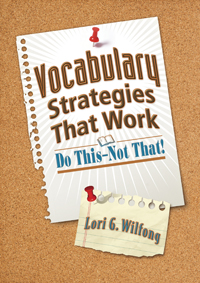Teach Vocabulary Effectively
Vocabulary Strategies That Work: Do This – Not That!
by Lori Wilfong
(Eye On Education/Routledge, 2013 – Learn more)
Reviewed by Brooke Schultz
Vocabulary Strategies That Work: Do This – Not That! provides teachers working with students in 4th through 10th grades with actionable ideas for teaching vocabulary effectively. Author Lori Wilfong’s 7-chapter book covers these topics:
Select Words to Teach
- Use Strategies to Engage Students in Word Study
- Help Students Come Up with Their Own Definitions
- Assess Student Use of Words in Authentic Writing and Speaking
- Teach Students Morphological Strategies to Figure Out Words
- Use Symbols and Pictures to Help Bring Vocabulary to Life
- Highlight and Use a Word Wall in Classroom Instruction
- Use and Apply Vocabulary Words Regularly
- Allow Opportunities for Wide Reading
- Model the Use of Academic Language at All Times
Each chapter opens with real-life scenarios about teaching vocabulary. The author begins by briefly stating her claim, with research, for why a particular concept is important. Next, she presents three or four research-based strategies, explains how to implement the strategy across content areas, and includes graphic organizers as needed. For strategies where there is not a particular graphic organizer, she includes samples of the strategy “in action.”
Wilfong ends each chapter with a “Common Core Connection” that describes how the strategy addresses specific CCSS standards for students in grades 4 through 10. She also includes an “Action Steps” reflection that asks readers specific questions and guides and challenges them to implement the strategies from the chapter.
Excellent for novice and veteran teachers
This excellent book is written not only for ELA and literacy teachers but content area teachers who want to strengthen students’ grasp of the academic vocabulary associated with their subject. I appreciated how Wilfong presented the research in a manner that’s easy to read and follow, with the inclusion of many “ready to go” graphic organizers, examples of how to implement strategies across curricular areas, and a reflection piece to guide teachers in the implementation process. I have used some of the strategies described by Wilfong in the past; however, there were several new strategies that I used immediately when I designed a vocabulary choice board.
This book provides updated strategies for veteran teachers, as well as a solid starting point for new teachers. Lori Wilfong makes teaching vocabulary “non-threatening” for content teachers — an important plus! In closing, I found this book to be clearly written, user friendly, researched based, directly connected to the Common Core Standards, and applicable to all teachers who have a need to teach vocabulary. And that’s just about everyone.
Brooke Schultz teaches 6th grade reading at Blue Earth Area Middle School. She has taught 8th grade English, special education at a care and treatment facility, and 5th and 6th grade. She earned a master’s degree in differentiated instruction. Brooke is a Professional Learning Community Leader, new teacher mentor, and peer coach. In addition, Brooke has been trained in the AFT Educational Research and Dissemination Program in the School, Family, and Community Partnerships Strand.



































